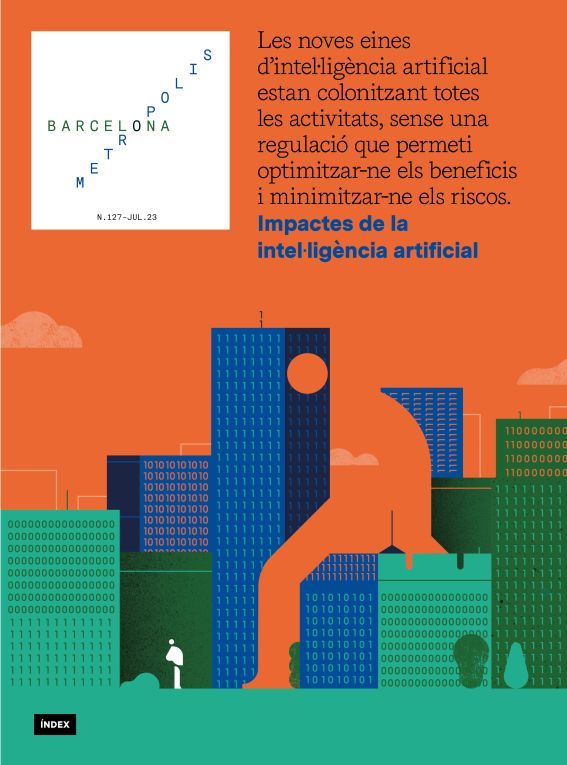Josep Tarradellas Airport, a major hub of activity
- Open data
- Jul 23
- 4 mins
Oriol Pàmies, texts / Carles Javierre Kohan, infographics
An airport acts as a major gateway to the city or region it serves. Barcelona airport, located in the municipality of El Prat de Llobregat, is a transport hub and a catalyst for economic activity that can generate an annual gross turnover of 16.4 billion euros, 6.8% of Catalonia’s GDP. Some of the airport’s distinctive features include the facts that a single low-cost airline, Vueling, handles 42% of the passengers and 29% of the routes, and that it is surrounded by wildlife reserves under the Natura 2000 network of protected areas.

In sixth place
Operating with a weekly average of 800,000 users, Barcelona airport is the sixth busiest airport in Europe. Looking back, aircraft traffic shows two peak periods, the first (2007-2008) occurred prior to the Barcelona-Madrid HST being brought into service and the global recession, while the Covid pandemic interrupted the second period, in 2019. The record of 344,563 flights also marked the highest volume of greenhouse gas emissions: 514,318 tonnes of CO2, a challenge for the new Alliance for Air Transport Sustainability in Spain (AST).



Functionality and the environment
The airport’s master plan, approved in 1999 and implemented for the most part, designed the facility for a maximum of 90 flights per day, with mixed use of the two main runways. Since 2006, the actual maximum number of flights has been 78 (40 take-offs and 38 landings), in the wake of pressure from local councils and residents of Castelldefels and Gavà, which led to the separation of the two main runways (the shorter one close to the sea for take-offs, the inner one for landings and the cross runway for special circumstances) to reduce the noise levels over residential areas. However, five per cent of aircraft are too large for the short runway.


Two terminals that could be three
With the existing number of boarding areas and space, the capacity of terminals T1 and T2 stands at 55 million passengers per year, a figure not much higher than the 52.7 million reached in 2019 (the difference is only 4%). The health crisis provided an unexpected break, but in 2022, still in the post-Covid recovery phase, the volume of users amounted to 41.6 million, 76% of the maximum. The construction of a satellite terminal connected underground to T1, foreseen in the master plan, would raise the infrastructure’s capacity to 70 million passengers, a figure similar to that recorded in 2019 by first-class facilities such as Amsterdam (71.7) and Frankfurt (70.6). It would also add parking space for wide-body aircraft, those used for long-haul flights. The impact of tourism means that the volume of users varies considerably depending on the time of year.
Summer is the busiest period for airport operations, as shown by the ranking of months with the highest passenger traffic. In a single day, 19 August 2019, 181,206 people transited through the airport. The maximum number of daily operations (1,140) was recorded on 17 May 2017.


Looking towards Europe
Some 60.2% of the passengers passing through the Barcelona-El Prat terminals are travelling to or from the 118 European airports connected to the Catalan capital, mostly from EU countries (45.5%). Domestic traffic represents 29.2% of passengers, with the Balearic Islands and Madrid as the main destinations out of a total of 28 available. Intercontinental flights account for the remaining 10.6%.


Tourism is the driving force
Users of Josep Tarradellas Barcelona-El Prat airport travel on scheduled flights (99%) to short or medium-haul destinations in Spain, Europe or North Africa (only 7.9% travel to America, the Middle East or Asia), mostly with low-cost airlines (73%) and, above all, for sightseeing purposes (55%).


Barcelona-Balearic Islands air shuttle
Whereas the Barcelona-El Prat – Madrid-Barajas route was the most frequented until 2019, it would be the Palma route as of 2020. High-speed trains have turned the market around and now cover 75% of the demand of the corridor that had been dominated by Iberia’s air shuttle. In fact, in the 2010-2022 figures, the Balearic airports amounted to 42.8 million passengers, much more than Madrid. The fact that Barcelona serves as the preferred connection with the islands no doubt accounts for the high number of people using El Prat airport as a stopover between two flights.


Rise in connections with the United States
The United Kingdom, France, Germany and Italy alternate year after year as the countries of origin and destination of most passengers at Barcelona airport. These four European countries bring the most tourism to Barcelona and are also among the most visited by Catalans. A recent development has been the rise in traffic with the United States, the only non-European country in the top 10. According to the Air Routes Development Committee, one of the goals pursued by economic agents is to increase intercontinental routes, whose number is expected to rise to 46 this summer.


The newsletter
Subscribe to our newsletter to keep up to date with Barcelona Metròpolis' new developments




